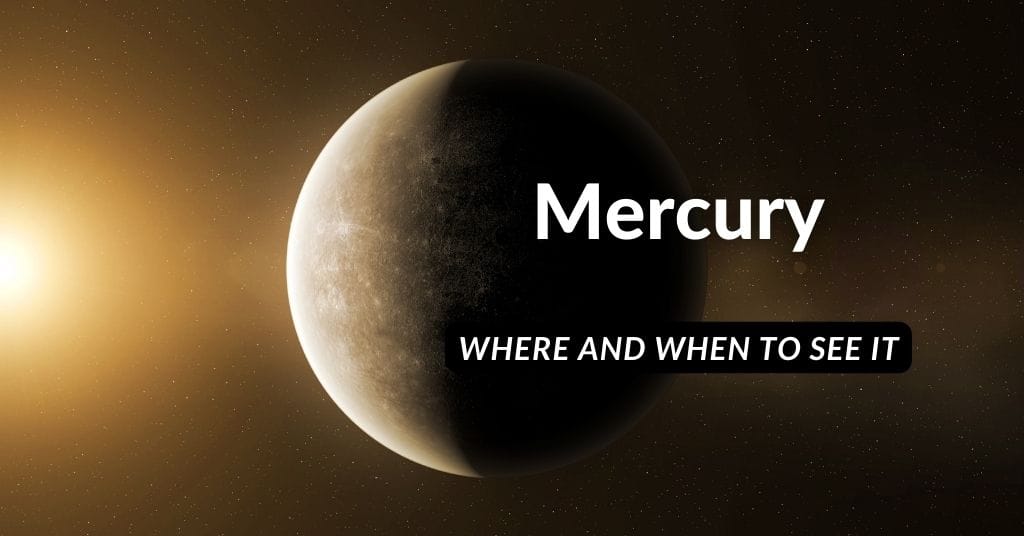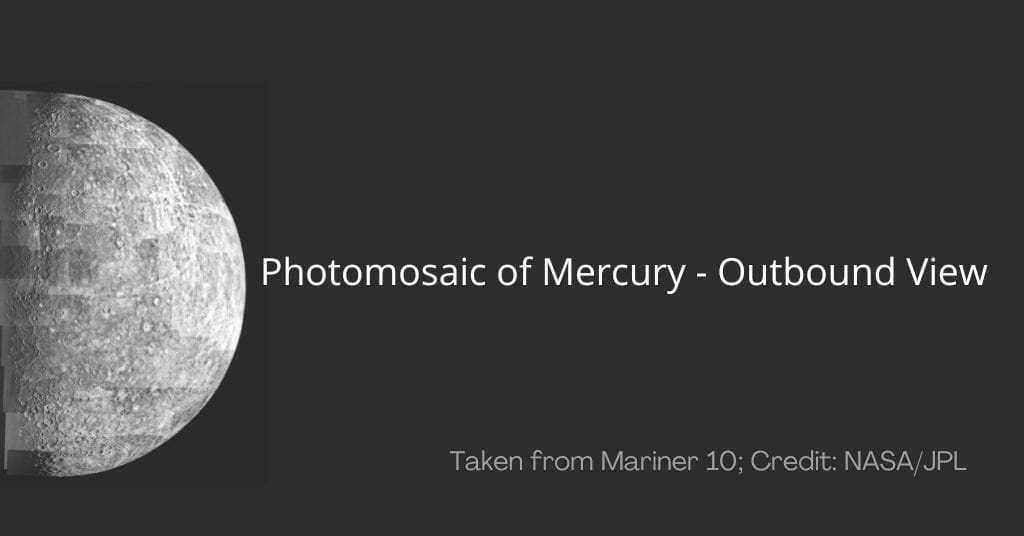Is Mercury visible through my telescope? What can I see of Mercury? It is the smallest planet in our solar system and the closest to our Sun. Here’s what to know about seeing Mercury through a telescope, binoculars, or with the naked-eye.

When is Mercury visible? What does Mercury look like through a telescope? To the naked-eye, Mercury appears a bright magnitude –1 star. At best, Mercury through a home telescope appears as a miniature crescent or half moon. The planet is only seen a couple of times a year in a two-week window, low in the sky.
Read on for dates…
About Mercury
Mercury orbits the Sun inside our planet’s orbit and at 0.39 AU is closer to the Sun than any other planet. It never moves beyond 28º from the Sun and so is observed within an hour or two after sunset or before the sunrise, depending on your latitude.
Mercury is a little more than a third of the sphere size of the Earth, and its mass is a mere 0.06 of the Earth’s. Its orbit takes about a quarter of the time of Earth’s and it has an inclination of 7º to the ecliptic plane. Its day-length equals 175.94 Earth solar days.
The planet was named after the messenger of the Roman gods, who had wings on his helmet and shoes, and as the planet ‘dashes’ around the Sun, it was considered a rightful name (source: NASA).

where and when to see Mercury
Mercury is the most elusive of the naked-eye planets, being visible only near the western horizon at dusk or the eastern horizon at dawn for two week intervals a couple of times during the year.
Dickinson in NightWatch
The best time to see Mercury is on dusk or around dawn during the two-week window, that’s twice a year. I like to use dateandtime.org to check for more exact times for what’s in the sky at my location. As well most astronomy apps for your device will offer you this information.
Windows of best time to see Mercury
| Year | Evening Sky | Morning Sky |
| 2022 | Early Jan; Late April | Mid-Oct |
| 2023 | Early April | Late Sep |
| 2024 | Late Mar | Early Sep |
| 2025 | Early Mar | Mid-Aug; Early Nov |
Other dates for the Southern Hemisphere in 2022 — 30 and 31 July after sunset low in the west sky. Look for it during twilight, lying just below the slither of a waxing Moon on the 30th. This is one of the easiest times to find it, because you can use the Moon as a guide.
Note: It is harder to see Mercury the further away you are from the equator … at mid-latitudes especially (from the tropics to the poles). From the equator, Mercury can be seen up to two hours either after the Sun sets or before the Sun rises during the times .
How to find Mercury
- Look above the horizon after sunset or before sunrise on the dates cited as best for observing.
- Use the Moon as a guide if it in the vicinity of Mercury
- Use low power — binoculars or telescope, so you get a wide view of the horizon or Moon before looking for Mercury.
- Once you find it, adjust the focus and magnification until it looks clear and sharp as possible.
As I cover in my tips on viewing stars and planets in the city, trying to view Mercury will be difficult in a built up area, as it sits low in the sky (above the horizon). You’re best with an elevated spot away from buildings, light pollution, and trees.
Magnification to see Mercury
Like the magnification to see Venus, the typical for planetary inspection of 150x works for Mercury. But the best you’ll see of Mercury through a telescope are the phases. Some practised observers consider a good set of astronomy binoculars work best. Though you need a steady support or tripod (I wrote how to use a camera tripod for this).
What does Mercury look like through a telescope
There’s not much to see of Mercury through a telescope (or binoculars). Phases of Mercury are your best outcome, such as a tiny crescent or half shape of Mercury as it quickly moves back and forth around the Sun displaying to us changing day and night sides (phases).
Like Mars, Mercury’s surface is visible. But distance from Earth and Mercury’s small size make views of Mercury’s features impossible with a typical backyard setup. Using a 16″ Dob, amateur astrophotographer, Tom Williams, tweeted an amazing capture of Mercury through his telescope in April 2022.
Features of Mercury
Mercury has no moons and has no rings. Like Mars and Pluto, Mercury also has no clouds but you won’t see its surface features from your home astronomy gear. Rather, images taken from much more sophisticated technology provide our best views of Mercury’s surface features.

Like the other inner planets Earth, Venus, and Mars, Mercury is terrestrial or rocky, versus the gaseous, like the planets of Neptune, Uranus, Saturn, and Jupiter. The NASA pics show Mercury’s dominant features are craters, not unlike our Moon’s surface.
Information sources
NASA resource package: Mercury | Nightwatch, a Practical Guide to Viewing the Universe by Terence Dickinson (available at Amazon – affiliate). This book contains sky charts and has a spring binding and so is practical for use on location. | Astronomy Australia Year Guide to the Night Sky (affiliate link) by Wallace, Dawes, and Northfield includes all sky maps and much more information for stargazing down under
